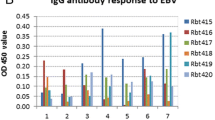Abstract
Most studies of the course of primary infection by Epstein–Barr virus (EBV, associated with Burkitt's lymphoma and naso-pharyngeal carcinoma1,2) have been made with human and other primate B lymphocytes, the chief naturally susceptible host cell type3. In vitro infection of B lymphocytes results, however, in their transformation into permanent lymphoid cell types in which the lytic cycle is virtually suppressed. Infection of B lymphocytes is sharply restricted to those cells that carry surface receptors for immunoglobin and the C3 component of complement. Infectibility may be entirely determined by the presence of EBV virus receptors, which is itself closely correlated with the presence of receptors for B cell-specific complement (C3d), but the establishment of the latent transformed state of host cells may well involve other internal characteristics of the differentiated B cell. We now report that, by means of the technique for implanting EBV receptors into the membranes of cells that lack them4, mouse lymphocytes can be infected with EBV resulting in a complete viral cycle, not in a state of latent transformation.
Similar content being viewed by others
References
Epstein, M. A. & Achong, B. G. in The Epstein-Ban Virus (eds Epstein, M. A. & Achong, B. G.) 321–338 (Springer, Berlin, 1979).
Klein, G. New Engl. J. Med. 293, 1353–1357 (1975).
Miller, G. in Viral Oncology (ed. Klein, G.) 713–738 (Raven, New York, 1980).
Volsky, D. J., Shapiro, I. M. & Klein, G. Proc. natn. Acad. Sci. U.S.A. 77, 5453–5457 (1980).
Menezes, J., Leibold, W. & Klein, G. Expl Cell Res. 92, 478–484 (1975).
Miller, G. & Lipman, M. Proc. natn. Acad. Sci. U.S.A. 70, 190–194 (1973).
Hoggan, M. D., Bowe, W. P., Black, P.H. & Hubner, R.J. Proc. natn. Acad. Sci. U.S.A. 53, 12–19 (1965).
Moar, M. H. & Klein, G. Biochim. biophys. Acta 519, 46–64 (1978).
Klein, G., Dombos, L. & Gothoskar, B. Int. J. Cancer 10, 44–57 (1972).
Ernberg, L., Masucci, G. & Klein, G. Int. J. Cancer 17, 197–203 (1976).
Reedman, B. M. & Klein, G. Int. J. Cancer 11, 499–520 (1973).
Hinuma, Y. & Grace, J. T. Proc. Soc. exp. Biol. Med. 124, 107–111 (1967).
Author information
Authors and Affiliations
Rights and permissions
About this article
Cite this article
Volsky, D., Klein, G., Volsky, B. et al. Production of infectious Epstein–Barr virus in mouse lymphocytes. Nature 293, 399–401 (1981). https://doi.org/10.1038/293399a0
Received:
Accepted:
Issue Date:
DOI: https://doi.org/10.1038/293399a0
- Springer Nature Limited
This article is cited by
-
Epstein-Barr virus (EBV), lymphocytes and transformation
Journal of Cancer Research and Clinical Oncology (1983)
-
The role of gene dosage and genetic transpositions in carcinogenesis
Nature (1981)





